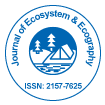Our Group organises 3000+ Global Conferenceseries Events every year across USA, Europe & Asia with support from 1000 more scientific Societies and Publishes 700+ Open Access Journals which contains over 50000 eminent personalities, reputed scientists as editorial board members.
Open Access Journals gaining more Readers and Citations
700 Journals and 15,000,000 Readers Each Journal is getting 25,000+ Readers
Google Scholar citation report
Citations : 2854
Journal of Ecosystem & Ecography received 2854 citations as per Google Scholar report
Journal of Ecosystem & Ecography peer review process verified at publons
Indexed In
- CAS Source Index (CASSI)
- Index Copernicus
- Google Scholar
- Sherpa Romeo
- Online Access to Research in the Environment (OARE)
- Open J Gate
- Genamics JournalSeek
- Ulrich's Periodicals Directory
- Access to Global Online Research in Agriculture (AGORA)
- Electronic Journals Library
- RefSeek
- Hamdard University
- EBSCO A-Z
- OCLC- WorldCat
- SWB online catalog
- Virtual Library of Biology (vifabio)
- Publons
- Geneva Foundation for Medical Education and Research
- Euro Pub
Useful Links
Recommended Journals
Share This Page
Safe salad - Is it possible to produce safe baby leaves?
Joint Conference International Conference on Environmental Microbiology and Microbial Ecology & International Conference on Ecology and Ecosystems
Lars Mogren
Swedish University of Agricultural Sciences, Sweden
ScientificTracks Abstracts: J Ecosyst Ecography
Abstract
Statement of the Problem: Vegetables are an essential component of a healthy diet. During the last decades, outbreaks of foodborne illnesses have increasingly been linked to fresh and/or minimally processed vegetables. Shigatoxin producing E. coli, causing EHEC infections, has been the causal agent for major outbreaks both in Sweden and abroad with leafy vegetables and sprouts. This pathogen is particularly severe due to its severe symptoms and low infectious dosis. The major source for contamination is associated with animal or human feces. Contamination can occur in the entire farm-to-fork chain and failure during preharvest may not be counteracted by processing. This project focus on the whole chain from production to consumer regarding baby leaf crops. Methodology & Theoretical Orientation: A four year project is called ��?Safe Salad�. It is including several research groups and applies a novel and unique approach, as it focuses on the vector, namely the plant and its microflora. It uses a comprehensive approach from farm to fork. Studies include interactions between cropping and processing environment and the leaf microflora and the prevalence of EHEC are used as a basis for risk assessment and identification of risk factors before harvest and of vegetables at risk. The impact of nitrogen supply to the crop is highlighted. Explanatory models for adhesion on the leaf via the existing biofilm and the significance of the leaf microflora for disease development is studied in animal trials. Conclusion & Significance: The main conclusion is that there are no single way to prevent and exclude E. coli reaching the farm to fork chain but there are several methods to reduce the risks at critical stages.Biography
Lars Mogren has a background in horticulture and produce quality. His main focus has been the role of pre-harvest factors on post-harvest quality of field grown vegetables. He is Coordinator of a four year research project called safe salad which includes field and greenhouse trials, laboratory analyses, intervention studies and risk assessments.

 Spanish
Spanish  Chinese
Chinese  Russian
Russian  German
German  French
French  Japanese
Japanese  Portuguese
Portuguese  Hindi
Hindi 
